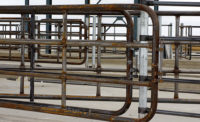State of the Industry 2018
State of Animal Handling 2018
Targeting humane solutions: A look at animal welfare in the meat and poultry industry




From an animal welfare perspective, 2018 has been a relative continuation of the past few years. Many of the same challenges still exist, but many within the industry have made the choice to take the challenges head-on and find solutions that work for them.
Regulatory actions appear to be stabilizing
Regulatory activity by the U.S. Food Safety and Inspection Service (FSIS) regarding the Humane Slaughter Act and 9 CFR 313 has been relatively stable since 2016. The majority (88 percent in 2016 and 94.4 percent in 2017) of enforcement actions were in response to ineffective stunning. Mechanical stunning methods, specifically firearm and captive bolt gun, were most commonly cited (87 percent and 88 percent in 2016 and 2017, respectively). Electrical stunning incidents were associated with approximately 8 percent or enforcement actions in 2016 and 2017. Ritual slaughter contributed 5 percent of stunning-related enforcement actions in 2016 and 2.1 percent in 2017. For a closer look at humane handling and stunning enforcement activity, check out the June 2018 issue of The National Provisioner.
Finding solutions
During the 2017 survey, the causes of ineffective mechanical stunning — 91 of 104 stunning-related enforcement actions — were identified as the FSIS enforcement actions were reviewed. In 2017, incorrect stun placement (70.3 percent), improper restraint (23.1 percent) and equipment problems (6.6 percent) were the three causes of mechanical stunning failures. These causes are repairable with appropriate corrective actions. Inaccurate stun placement is often the result of poor ergonomics for the stunner operator. It is always a good idea to allow the stunner operator to offer input regarding the layout of the stunner platform that fits him or her best.
Some inaccurate stun location problems occur in the barn or on the truck with animals that need to be euthanized. Restraint is not always needed to humanely euthanize cattle with captive bolt guns, but it typically helps. This is especially true for animals that are still alert enough to interact with the person carrying the captive bolt gun. It is a good idea to train barn personnel that perform euthanasia procedures in the pens and on trucks to effectively restrain animals in that space if necessary. This often requires using a chute with some form of head restraint if the animal is still able to walk.
If the animal is non-ambulatory with active and unpredictable head movement, there are restraint methods veterinarians often use that would be appropriate in such cases. A common method of head restraint for non-ambulatory cattle involves placing a rope halter on the head of the animal, then passing the halter lead around the exposed hind leg above the hock. A second handler with sufficient strength would then hold the end of the lead or the lead could be tied to itself. If someone holds the rope, he must never wrap the rope around his hand, which could be broken if the animal suddenly moves. If situations where this sort of procedure is used are likely to occur, it is always best discuss the intent to use this or other restraint methods with the IIC before implementation so inspection personnel are not surprised by the use of a new method.
The customers want to know more
The interest that quick service restaurants and retailers have in animal welfare is very likely to continue into the foreseeable future. Some QSRs and retailers have a better idea of what happens during the typical life of an animal in their supply chain. In an effort to learn more, some of these companies have developed survey tools to distribute to their animal protein suppliers. Some suppliers take their survey seriously and make a meaningful effort to answer the questions and others tend to go through the motions. For the benefit of your business, if you are a supplier to a company that sends such a survey tool, make an effort to answer the questions well. A response without effort is unlikely to contribute positively to the relationship between customer and supplier. For many suppliers, these questions from their customers have prompted them to learn more about their own supply chains.
As we enter the final stretch of 2018, remember to keep looking for ways to continue to improve. Communication is essential to this goal. A great place to talk about the challenges and solutions to many humane handling and stunning related issues is the North American Meat Institute’s Animal Care and Handling Conference, Oct. 18 and 19 in Kansas City, Mo. NP
Looking for a reprint of this article?
From high-res PDFs to custom plaques, order your copy today!









